Famous Faces at The Vine
Upon walking into our Centre you will see a beautiful stained glass art piece that depicts many famous faces from Belfast. These people have also inspired the names of the rooms that are in The Vine Centre. As you walk around the building you will see names like Robinson, Carmichael, Nevin, Herzog, and Hewitt on the outside of the doors.
Because of these people's incredible contribution to the fields in which they worked, we have decided to honor them. Below you will see the pictures of the stained glass and a short description of the work or contribution that each of these influential people have given to our community and to the world.
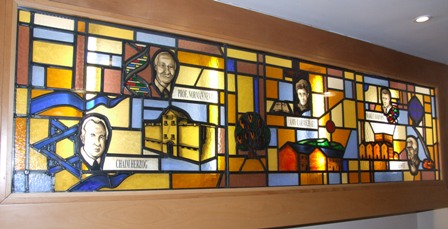
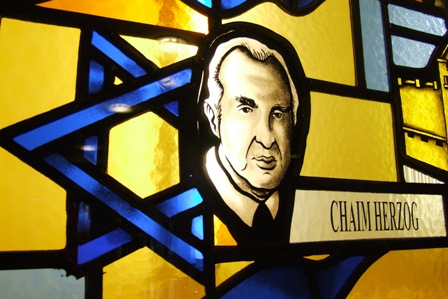
Chaim Herzog (1918-1997)
Israel's Longest Serving President
One of the most influential figures in the early years of the State of Israel, Chaim Herzog, who became Israel's sixth and longest serving President, was born on September 17th 1918 at 185 Clifton Park Avenue (now 2 Norman Villas). When his father, Dr. Issac Herzog, was appointed Chief Rabbi of Ireland, the family moved to Dublin where Chaim spent most of his formative years. The family emigrated to Palestine, then under British mandate, in 1935, though Chaim subsequently moved to London to finish his education. In London he studied Law and was called to the Bar in 1942. He joined the British Army during the Second World War and saw first hand the terrible suffering of Jews in the Nazi concentration camps.
This experience fuelled his determination to help set up a Jewish state and he returned to Palestine in 1946. Active in the Haganah Jewish underground, he became a successful general in the Israeli Army and later held several important positions after Israel was created in 1948, including chief delegate to the United Nations from 1975 to 1978. Most notably he served two five-year terms as Israel's sixth President between 1983 and 1993. He died four years after resigning. A blue plaque marks his birthplace off the Cliftonville Road.
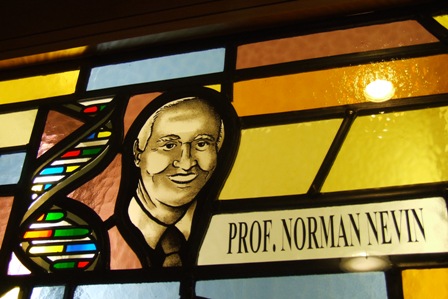
Prof. Norman Nevin
Professor Emeritus In Medical Genetics
Queen's University,
Norman Nevin is Professor of Medical Genetics at The Queen's
He was a member of the Council of Clinical Genetics Society from 1970 to 1993 and President from 1991 to 1992. He has been a member of the Gene Therapy Advisory Committee since 1993 and its Chair since 1996. He was also a Member of the Human Genetics Advisory Commission from 1996 to 1999 and has been Vice-Chairman of the Research Ethics Committee, The Queen's
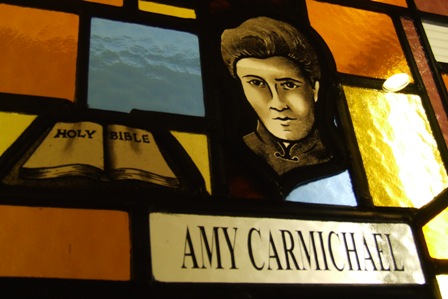
Amy Charmichael (1867-1951)
Protecting The Vulnerable
Amy Beatrice Carmichael dedicated her life to missionary work and left behind a rich heritage of books, hymns and poetry. Born on December 16th 1867 in the County Down
Brought up a Presbyterian, Amy's life changed after she and her brothers helped a destitute old woman after church service, and, though initially embarrassed to be seen in the woman's company by members of her congregation, heard God's voice encouraging her. One of her brothers recalled that she shut herself in a room at 21
Her overseas mission work began in
Known as 'Amma' or mother, she dedicated the next fifty years of her life to rescuing young girls from situations of great danger. The mission and orphanage she established grew over the years and in 1912, came recognition from Queen Mary and a hospital was later added. Over the years Amy would take in many hundreds of vulnerable children, often travelling great distances to rescue them. She and her co-workers not only rescued the children but gave them a Christian upbringing too. Not all the workers were Indian but all, including Amy, wore Indian dress.
Amy's health became precarious after a fall in 1931 and she was bedridden for the last years of her life, dying in 1951. However, her great legacy, the Dohnavur Fellowship, still exists to protect vulnerable children in
A blue plaque was erected to Amy at the
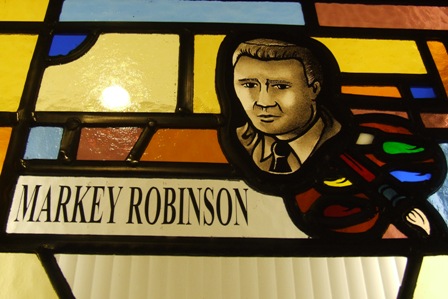
Markey Robinson
Artist
Markey Robinson was born in Belfast in 1918. The son of a house painter, he attended Perth Street Public Elementary School, studied for a time at the Belfast College of art and visited Paris on a number of occasions. He drew upon his extensive experiences for the diversity of subjects and ideas which he portrayed throughout his life.
Markey was a primitive painter, a colourful character, a man of great complexity; are all descriptions which have characterised Markey over the years.
Markey's landscape is probably the work for which he is best known. It is an area which he has worked on as consistently as that of still-life, clown and figure studies. Like all of the Figurists, Markey paints from memory and mind. It is interesting to note Markey's change of palette in relation to the different places he is painting. His Irish landscape is cold, damp and misty, reflected in colours of grey, blue, green and white. His Spanish scenes are executed in vivid, hot and vibrating colours of red, orange, electric blue, pink and yellow. Like George Campbell, who used varying palettes for his Irish and Spanish works, so Markey brings about an atmosphere through the use of colour and tone.
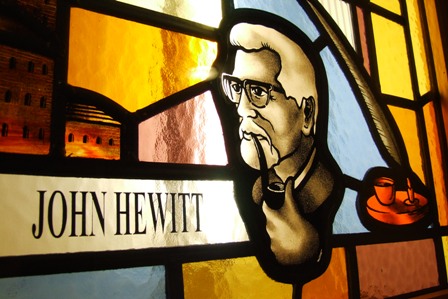
John Hewitt (1907-1987)
Poet
John Harold Hewitt, who was born in Belfast, Northern Ireland, was the most significant Irish poet to emerge before the 1960s generation of Irish poets that included Seamus Heaney, Derek Mahon and Michael Longley. He was appointed the first writer-in-residence at Queen's University Belfast in 1976. His collections include The Day of the Corncrake (1969) and Out of My Time: Poems 1969 to 1974 (1974). He was also made a Freeman of the City of
Hewitt had an active political life, describing himself as "a man of the left", and was involved in the British Labour Party, the Fabian Society and the Belfast Peace League. He was attracted to the Ulster dissenting tradition and was drawn to a concept of regional identity within the island of Ireland, describing his identity as Ulster, Irish, British and European.
His life and work are celebrated in two prominent ways - the annual John Hewitt International Summer School - and, less conventionally, a Belfast pub is named after him - the John Hewitt Bar and Restaurant, which is situated on the city's Donegall Street and which opened in 1999. The bar was named after him as he officially opened the Belfast Unemployed Resource Centre, which owns the establishment. It is a popular meeting place for local writers, musicians, journalists, students and artists. Both the Belfast Festival at Queen's and the Belfast Film Festival use the venue to stage events.